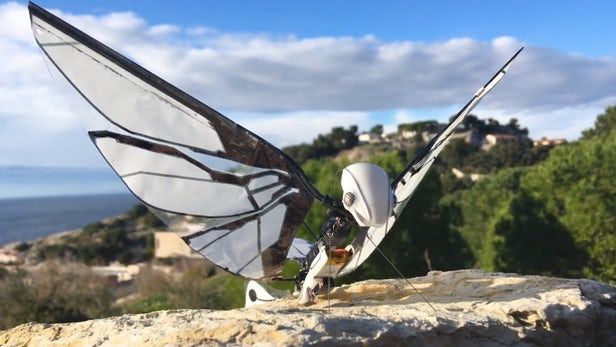Category: transhumanism – Page 64

Bugatti uses SLM Solutions additive manufacturing systems in component production
Sports car maker Bugatti (Molsheim, France) used SLM Solutions’ (Lübeck, Germany) metal additive manufacturing technology to produce automotive components. The components were manufactured in the aerospace alloy Ti6Al4V in cooperation with the Fraunhofer Research Institution for Additive Manufacturing Technologies (Fraunhofer IAPT; Hamburg, Germany) and Bionic Production (Lüneburg, Germany) on a SLM 500 selective laser melting system featuring four 400 W lasers.
A caliper test showed that additively produced metal components can cope with extreme strength, stiffness, and temperature requirements at speeds of over 375 km/h with a braking force of 1.35 g and brake disc temperatures up to 1100°C, says Frank Götzke, Head of New Technologies at Bugatti. The test also showed that a tensile strength of 1250 N/mm and a material density over 99.7% was achieved.

MetaFly is that flying robotic insect you’ve been looking for
Five years ago, French aeronautical engineer Edwin Van Ruymbeke successfully crowdfunded his Bionic Bird – it’s a remote-control model that flies by flapping its wings, just like a real bird. Now he’s back, with the insect-inspired MetaFly.

Transhumanism, the Lazy Way to Human ‘Improvement’
Well, Wesley J Smith just did another hit piece against Transhumanism. https://www.nationalreview.com/corner/transhumanism-the-lazy…provement/
It’s full of his usual horrible attempts to justify his intelligent design roots while trying to tell people he doesn’t have any religious reasons for it. But, then again, what can you expect from something from the National Review.
Sometimes you have to laugh. In “Transhumanism and the Death of Human Exceptionalism,” published in Aero, Peter Clarke quotes criticism I leveled against transhumanism from a piece I wrote entitled, “The Transhumanist Bill of Wrongs” From my piece:
Transhumanism would shatter human exceptionalism. The moral philosophy of the West holds that each human being is possessed of natural rights that adhere solely and merely because we are human. But transhumanists yearn to remake humanity in their own image—including as cyborgs, group personalities residing in the Internet Cloud, or AI-controlled machines.
That requires denigrating natural man as exceptional to justify our substantial deconstruction and redesign. Thus, rather than view human beings as exclusive rights-bearers, the [Transhumanist Bill of Rights] would grant rights to all “sentient entities,” a category that includes both the biological and mechanical.

Comma.ai founder George Hotz wants to free humanity from the AI simulation
The crowd didn’t much care either way. During the Q&A, an audience member asked Hotz if he would consider partnering with transhumanists — people who believe in humanity’s eventual evolution by way of merging the body and mind with robotics and AI — to found his church. Hotz was rather ambivalent to the idea; perhaps he didn’t think people would take him at his word. But if he does a start a church, the sermon he gave at SXSW yesterday was delivered to a room of would-be believers.
“Jailbreak the simulation”
#IAmTranshuman — Compilation #1 — U.S. Transhumanist Party / Transhuman Party
Leading transhumanists from a variety of backgrounds and perspectives provide concise, powerful statements as to why they are transhuman. The Transhuman Era has arrived; some of us are aware of this already, whereas others are transhuman but do not know it yet. The #IAmTranshuman campaign helps illustrate how emerging technologies and the accompanying shifts in thinking are already transforming everyday life.
This video was compiled and formatted by Tom Ross, the U.S. Transhumanist Party / Transhuman Party’s Director of Media Production: http://tomross.com/
The following transhumanists are featured, in order of appearance:
- B.J. Murphy, Director of Social Media, U.S. Transhumanist Party / Transhuman Party.
- Ira Pastor, Regeneration Advisor, U.S. Transhumanist Party / Transhuman Party.
- Tom Ross, Director of Media Production, U.S. Transhumanist Party / Transhuman Party.
- José Luis Cordeiro, Technology Advisor and Ambassador to Spain, U.S. Transhumanist Party / Transhuman Party.
- Charlie Kam, Director of Networking, California Transhumanist Party.
- Bill Andrews, Biotechnology Advisor, U.S. Transhumanist Party / Transhuman Party.
- Gennady Stolyarov II, Chairman, U.S. Transhumanist Party / Transhuman Party.
Learn more about the #IAmTranshuman campaign, the Transhuman Present Project (#TranshumanPresent), and how you can readily participate: https://transhumanist-party.org/2018/01/21/concrete-transhumanism/
You can participate in the #IAmTranshuman campaign by submitting still images or video recordings of one minute or less (15 seconds or less for Instagram stories, one minute or less for Instagram-compatible videos). Use the hashtag #IAmTranshuman, and let us know if you would like your video included in a subsequent compilation!
James Hughes’ Problems of Transhumanism: A Review (Part 5) – Article
This is Part 5 of a 5-part series by Chogwu Abdul, founder of the Transhumanist Enlightenment Café (TEC), where he explores the thought-provoking intricacies of James Hughes’ “Problems of Transhumanism.”
In this Final Part, he explores “Belief in Progress vs. Rational Uncertainty.”
Longevity and Age Reversal
Meanwhile, LIVE in Hollywood, FL today.
Brian Manning Delaney will join us with a presentation on “Navigating the Labyrinth of Dietary Restriction Methods.“
Followed with an Age Reversal Update by William Faloon.
William Faloon compiled the 1,500-page medical reference book Disease Prevention and Treatment, and his latest book is Pharmocracy: How Corrupt Deals and Misguided Medical Regulations Are Bankrupting America—and What to Do About It. He is also Director and Co-founder of the Life Extension Foundation.
To promote Life Extension’s innovative medical concepts, William Faloon has been featured in hundreds of media appearances including The Phil Donahue Show, The Joan Rivers Show, Tony Brown’s Journal, ABC News Day One, and Newsweek magazine.
Church of Perpetual Life, a science-based church is open to people of all faiths & belief systems. We are non-denominational & non-judgmental and a central gathering place of Transhumans. What unites us is our common faith, belief, and desire in Unlimited Life Spans.
James Hughes’ Problems of Transhumanism: A Review (Part 4) – Article
This is Part 4 of a 5-part series by Chogwu Abdul, founder of the Transhumanist Enlightenment Café (TEC), where he explores the thought-provoking intricacies of James Hughes’ “Problems of Transhumanism.”
In this Part, he explores “Moral Universalism vs. Relativism.”